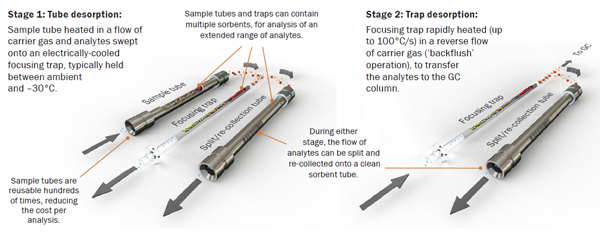This application note describes the performance of Markes’ thermal desorption (TD) systems for the GC–MS analysis of trace-level phthalates in air.
 Summary
Summary
The advantages of thermal desorption compared to conventional air monitoring methods for semi-volatiles are discussed. In addition, it is demonstrated how Markes’ innovative sample re-collection functionality facilitates TD method development by validating quantitative recovery of these challenging analytes all the way through the TD system. Excellent analytical precision, with RSDs <5% for all compounds, is shown and an independent field investigation of phthalate levels in urban air in Belgium is highlighted, which reported very high linearities (R2 ≥0.998), and limits of detection <0.23 ng/m3.
Introduction
Phthalates (diesters of phthalic acid) have been widely used since the 1950s as plasticisers, but several of them are now suspected of being endocrine disruptors and are classed as ‘substances of very high concern’ under the European REACH regulation. Furthermore, regulations in the EU, US and China ban or restrict the use of phthalates in children’s toys.
Monitoring phthalates in ambient or indoor air has traditionally involved pumped sampling of large volumes of air through a quartz or glass fibre filter to collect the particulate fraction, backed-up with a polyurethane foam cartridge or other sorbent to trap the vapour-phase fraction. Analytes are then solvent extracted from the two phases and concentrated using rotary evaporation or other traditional techniques, with subsequent analysis of the concentrated extracts by GC or GC–MS. However, these approaches suffer from several disadvantages.
The technique of thermal desorption (TD), in conjunction with GC or GC–MS, has been used for several decades to overcome these issues for the monitoring of lower-boiling airborne volatile organic compounds (VOCs), and is now increasingly being applied to measurement of SVOCs, including compounds boiling up to n-C44 (b.p. 550 °C).
Background to thermal desorption
Thermal desorption is a versatile, solvent-free pre‑concentration technique for gas chromatography that is used to analyse volatile and semi-volatile organic compounds (VOCs and SVOCs) in air/gas, liquids and solids. By concentrating organic analytes present in air (or released from a sample) into a very small volume of carrier gas in a two-stage process (see below), TD maximises sensitivity for trace-level target compounds, helps to minimise interferences, and routinely allows analyte detection at the ppb level or below. It also greatly improves sample throughput, by combining sample preparation, desorption/extraction, pre-concentration and GC injection into a single automated process.

Results and Discussion
Validation of analytical precision
Re-collection efficiency – Markes’ TD systems (manual and automated) are unique in allowing samples to be split and quantitatively re-collected onto a clean sorbent tube at the tube desorption and/or trap desorption stages. Re-collected samples can then be re-analysed for validation of analyte recovery as described in key international standards. Quantitative re-collection of thermal desorption
samples also overcomes the ‘one-shot’ limitation of traditional TD systems, and allows samples to be re-analysed under the same or different conditions – for example, with a selective detector or at a different split ratio to extend the dynamic range.
Conclusions
These studies show that Markes’ TD systems provide outstanding performance for a range of phthalates at typical environmental levels, with excellent system reproducibility (<5% RSD) and linearity (R2 ≥0.998), and MDLs below 0.25 ng/m3.
The high desorption efficiencies obtained (>96% relative to PCB-28) are also an important finding, because they demonstrate the robustness of Markes’ automated thermal desorption systems as a practical alternative to manual solvent extraction for monitoring these important high-boiling pollutants in ambient air.




